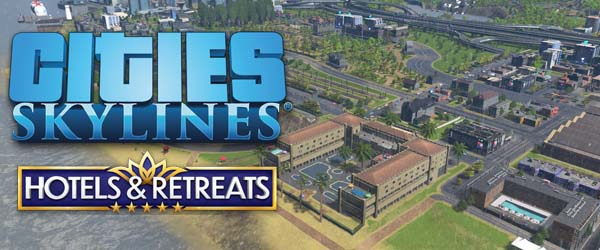
Surely this has to be the last DLC that Cities: Skylines is receiving, given that the sequel is due out this fall. This last wave of expansions and content creator packs has scratched a lot of very specific itches that I've had with Cities: Skylines for a long time, and they've had me playing the game a lot lately. I've been building a large city up over 100 thousand population, and also going back to some older save files and either upgrading them to use newer DLC assets, or to replace old mod assets with analogous official DLC assets.
A near seamless fit
What I really like about Hotels & Retreats is how seamlessly they fit into the existing game. Like with Industries, Campus, and Airports, I feel that Hotels & Retreats could easily have fallen into the trap of replacing old assets and rendering them moot or useless. Like, if the DLC had added a "resort area" mechanic using the Parklife area painting mechanic with modular hotels and resorts, it could easily have caused me to stop using the After Dark leisure and tourism district specializations (just like I've basically stopped using farm, forestry, oil, and ore industry specializations because I use the Industries areas instead).
Hotels & Retreats works very well alongside other expansion content!
Instead of feeling like a replacement for the existing tourism districts, the content of Hotels & Retreats is a great supplement. In fact, it feels like it could easily have been part of the After Dark expansion. Or the Parklife expansion. Or the Airports expansion. Or Plazas & Promenades. Or even the previous Financial Districts DLC.
Each hotel has preferences for proximity to a combination of city landmarks, shopping, offices, or nature. How well the hotel's location fits its unique combination of those 4 preferences will determine how popular it is for guests, which in turn will influence how much (if any) profit it makes, and the player can set its pricing accordingly. A business hotel placed in the middle of an IT or financial specialty district, along with some nearby commercial districts, will generate high profit; while a rental cabin will do best if placed in the vicinity of a nature preserve, in the middle of a forest, or along a pristine scenic coastline.
Each individual hotel's profit is aggregated into a total profit margin for the "chain" of hotels, and higher-level hotels are unlocked by increasing the weekly profit of the entire chain. So improperly-placed or poorly-performing hotels can be subsidized by the fully-occupied, perfectly-placed hotels with higher prices and profit margins.
Cheap, unprofitable niche hotels can be subsidized by the more popular and expensive hotels.
[More]
8424b6e9-a9f1-4b73-bdc8-0f5de5b5d48b|0|.0
Tags:Cities: Skylines, Cities: Skylines: Hotels and Retreats, hotel, resort, beach, park, tourism, roads, Cities: Skylines: Parklife, Cities: Skylines: Industries, Cities: Skylines: Natural Disasters
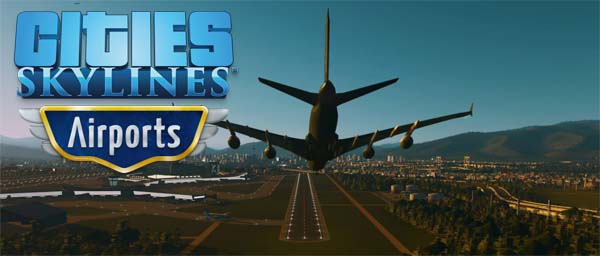
After releasing 2 full expansions every year since the launch of Cities: Skylines, expansions seemed to dry up after 2020. Sunset Harbor released in March of 2020, and there hasn't been any full expansion since then. I'm not sure if this is the result of Colossal Order shutting down its studio temporarily during the COVID-19 pandemic, or if they have just been busy working on a sequel. I had assumed that Cities: Skylines was done, and that Sunset Harbor would be the final expansion for the game. But that is not the case, as a new expansion was finally released at the end of January 2022.
The Airports expansion is yet another expansion pack using the area-painting mechanic that was introduced in the Parklife expansion in 2018, then re-used in Industries and Campus in the subsequent years. As such, I don't know that I really have much to say about Airports. A lot of the same compliments and criticisms that were already applied to Parklife, Industries, and Campus also apply here.
Campus, ironically, did not teach Colossal Order any lessons
The modular nature of the airport buildings, taxi paths, and runways provides quite a bit of customization. There are 3 styles of airports: a retro-style, a modern style, and an "ultra-modern" style. They are functionally the same, so don't fill different roles the way that different parks, industries, or university types did in their respective expansions. The airports are massive and expensive, but they can be shaped to fit into irregular spaces in or around your city. Unfortunately, there's not nearly as much expressiveness as what we were offered by Parklife.
Airports come in different styles, and are customizable (parking lots and garage are mod assets).
Of course, Airports suffers from the same problems that have plagued the previous expansions that used the leveled-areas concept.
A lot of the modular components are simply decorative and have no function other than to increase the area's abstract "attractiveness". In the case of airports, these include the various hangars, parked planes, and so forth. Even the air traffic control tower is a purely decorative object, rather than being necessary for the airport to work!
I've also never liked how the park areas (and now the airport areas) level up by increasing the total visitors, and industries level up based on the total goods produced. This is something that is easy to achieve by simply waiting in-game months or years for the number to go up, regardless of the size or quality of the park, industry, or airport. Because of that, it can be easy for an airport to jump out ahead in total visitors, such that the area can be leveled up immediately, and at any time, by simply placing new structures that bring the attractiveness up above the required threshold.
Airports level up based on the total passengers, which can be easily increased by simply waiting.
Instead, I wish these areas would level up based on the weekly visitors (or good produced, for industries), rather than the cumulative total. This is a much better metric of the capacity of a park, industry, or airport. This is one of the things that the Campus expansion did a bit better than the others, since the universities level up based on the current number of students and the number of research projects. The amount of students is capped by the size of the school, and the research projects are semi-randomly created based on the funding levels and access to research facilities.
Airports aren't like that. Leveling them up feels much simpler and requires less effort and management from the player. Airports also cannot de-level (like universities could) if you fail to maintain its attractiveness, and since total passenger count is something that can never decrease the way that a university's student attendance can decline -- or the way that weekly passenger count could potentially decrease. [More]
9d933baf-f859-49f8-9255-79e2379ce105|0|.0
Tags:Cities: Skylines, Cities: Skylines: Airports, Colossal Order, Paradox Interactive, steam, PC, expansion, airport, airplane, airline, hotel
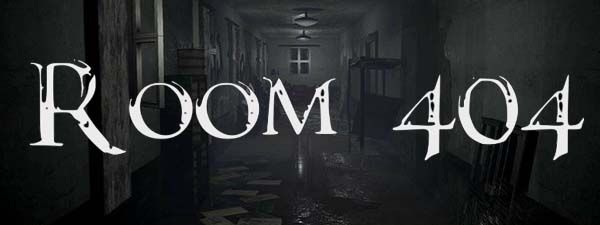
Since I'm in between major releases, it's time for yet another indie Steam game. This time, it'll be a game that was released this year! Only a few weeks ago, in fact! I picked up Room 404 (along with a couple handfuls of other games) in the Steam Summer Sale a couple weeks ago. It's yet another attempt to scratch that horror itch that was left behind by the cancellation of P.T.. Room 404 completely failed to scratch that itch.
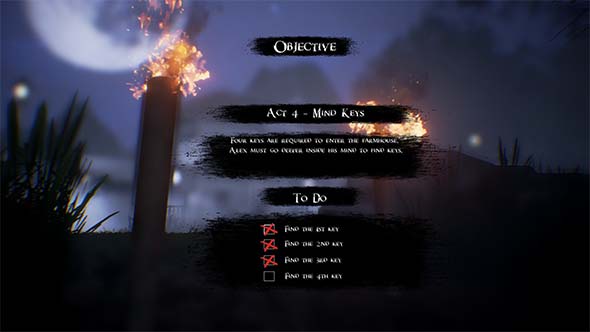
Practically the whole game consists of walking around collecting keys. Not very scary...
There's really not much to this game at all. It's only a couple hours long and isn't very mechanically or intellectually substantive. It falls firmly into the category of "walking simulator", and even that might be generous. There's basically three types of puzzles that get re-used throughout the game - if you can call them "puzzles", that is. All of them are resolved by simply exploring the linear areas to find the triggers to solve the puzzle. Numeric keypad locks are opened by searching adjoining hallways and rooms for the numbers that make up the combo, which are hidden in plain sight or in obvious locations. If you're not looking for keypad numbers, then you're looking for simple keys. The second puzzle type involves simply lighting candles in the right order. The final puzzle (which only appears once) puts you in a tiny maze and shows you a map that highlights your current location and the location of the exit. You turn three corners, and you're done.
Some of these puzzles are made a little bit confusing by the game's only real feature: its changing landscape. At several points in the game, you'll come across a locked door or obstacle, which will force you to turn around to find that your environment has changed. In some cases, this will mean that another door will suddenly be open, allowing you to explore a previously-closed off room. In other cases, you simply turn back around to find the obstacles gone. These situations are always accompanied by an audio cue to notify you that something has changed, and the sound of a creaking door will often notify you to go back and check previously-closed doors. In other cases, it's not always obvious what you're supposed to do, and I swear at least a couple puzzles were solved by my simply turning around in circles a couple times wondering what the heck the game wanted me to do.
Puzzles don't get any more complicated than finding keys and numbers hidden in plain sight.
There is an enemy in the game that can kill you on contact, just like in so many other "run and hide" horror games. However, in this case, you can't actually run or hide... [More]
30d421b7-c35e-4626-8f21-2b3bc34eef7d|0|.0
Tags:Room 404, 3DTM, Machine Bear Software, Steam, Steam Greenlight, psychological horror, horror, indie gaming, hotel, murder, father, son
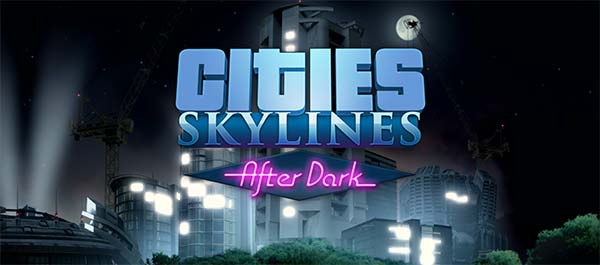
It's been a very long time since I've had a city-building game that I really enjoy. So it was a real treat to find Cities: Skylines last year. It was the first game to really capture the magic of the classic SimCity games and make them work in full 3-D, and managed to achieve the goal of abstract population agency that the SimCity reboot failed so horribly at. But as much as I loved Skylines, I was also very aware of many of its limitations. It didn't have as much content as you might expect from a game coming from a larger publisher (like EA), and there were certain elements of its abstraction that felt a little shallow or weird. The game's first expansion, After Dark, tries to address these limitations, but it doesn't really succeed.
The free update is a nice gesture, but ...
First and foremost, I have to clarify exactly what the expansion encompasses, since Colossal Order has created a bit of confusion on this topic. They launched a free update for the base Cities: Skylines game in parallel with the release of the After Dark expansion. This update included some of the core feature upgrades that the expansion's content depended on. Most notably, a day/night cycle, new zoned buildings, and upgraded crime systems. If you have Cities: Skylines, then you get these features as a free patch, and have probably been playing with them for months.
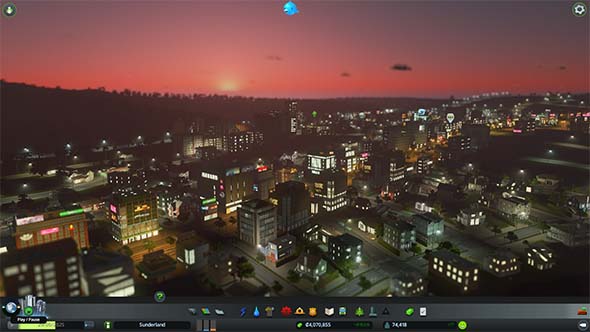
The day/night cycle is a free upgrade to the core game, but makes the core game feel somewhat incomplete.
While I applaud Colossal Order for the good will they foster by being willing to give away new functionality for free, this does kind of put players of the vanilla game in a strange situation. You get some of the new features, but not any of the ploppable buildings or city policy options that make them work. You get more crime, but not the prisons in which to lock up and rehabilitate criminals. You get the day/night cycle, but not the fancy new leisure and tourism zones that make nighttime mechanically relevant. In some ways, it takes the core game that felt very complete on its own, and suddenly makes it feel incomplete in subtle ways.
Fortunately, the menu gives you the option to turn the day/night cycle off, which helps to preserve the integrity of the original game. But then you don't get the new feature.
The update won't harm any of your existing save files though - with one major exception. If you made the unfortunate mistake of creating a city that was completely dependent on solar power, then the day/night cycle will screw that city over big time! In the core game, this was actually the most optimal way to go. Solar didn't pollute, wasn't dependent on depleting resources, and money was easy enough to make that the cost wasn't a big enough deterrent to using solar. But with the day/night update, once the sun goes down, all those fancy, expensive solar panels completely stop working! This can lead to your entire city going into a blackout as soon as you boot up your save file. Suddenly, not only is solar non-optimal, but it's practically useless since it doesn't work for half the game. And this isn't something that you can fix by just increasing solar power funding or building more plants; the power output drops to zero!
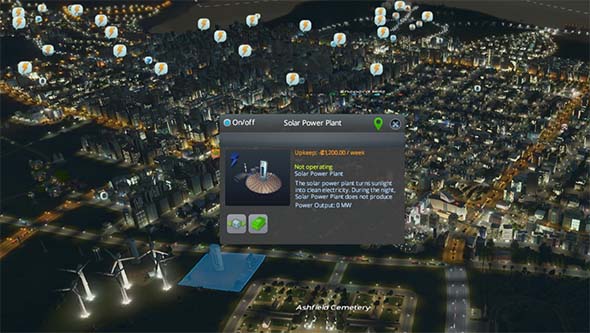
Solar power plants stop working completely during the night, leading to massive blackouts.
Fun at night, and in the sun
I did complain somewhat about the lack of a day-night cycle in the base game, but the implementation that Colossal Order gave us is a bit uncomfortable and awkward. The rapid progress of a "day" in the game means that they couldn't transition from day to night in a single game-day, or else the game would just be constantly flickering between day and night. The developers apparently didn't want to slow down the game-day either, since that would probably upset many elements of the game's economic and agent systems. So instead, your cities get about a month-and-a-half of day, followed by about a month-and-a-half of night. Individual citizens seem to go about a daily cycle within this time. They aren't bound to it though. I've seen some citizens go back and forth between home and a near-by job several times during the day-time, then spend the whole night out at a restaurant or nightclub; and other citizens can spend the entire daytime commuting to and from work only to spend most of the night sitting in the office. They start their cycles at staggered times during the day; thus, sparing us from the annoying pathfinding and gridlock issues that plagued SimCity (2013). It all ... works ... at a very abstract level; it just feels weird... [More]
f5d3fc25-4e52-471a-a9cb-17667d979a88|2|3.5
Tags:Cities: Skylines, Cities: Skylines: After Dark, Paradox Interactive, Colossal Order Ltd., PC, expansion, Steam, Steam Workshop, city simulation, day, night, tourism, leisure, beach, hotel, nightclub
|

| 12 | | | | | | | 60 | | 11 | | | | | | | 55 | | 10 | | | | | | | 50 | | 09 | | | | | | | 45 | | 08 | | | | | | | 40 | | 07 | | | | | | | 35 | | 06 | | | | | | | 30 | | 05 | | | | | | | 25 | | 04 | | | | | | | 20 | | 03 | | | | | | | 15 | | 02 | | | | | | | 10 | | 01 | | | | | | | 05 |
|